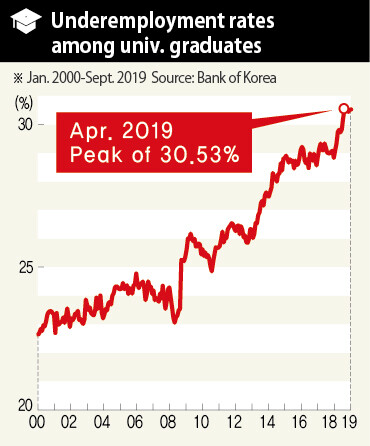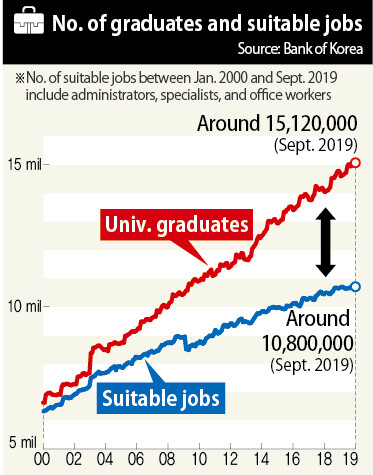hankyoreh
Links to other country sites 다른 나라 사이트 링크
30% of S. Korean graduates overqualified for their current jobs

The “underemployment rate,” representing university graduates who have chosen a profession below their qualifications, has passed the 30% mark for the first time, research findings show. The numbers indicate a lack of sufficient high-quality jobs to absorb the highly educated workers who are being produced as a result of overheated educational investment. Between eight and nine out of every 10 underemployed persons were also found to have remained underemployed after one to two years, suggesting that the “employment ladder” is not functioning effectively.
On Dec. 22, a report titled “Current Conditions and Characteristics of Underemployment” was published by Oh Sam-il, a division director in the Bank of Korea (BOK) research department, and research officer Kang Dal-hyeon. The results showed the underemployment rate for university graduates increasing steadily from 22.6% in January 2000 and passing 30% for the first time in March 2019, reaching 30.5% as of September. According to recent overseas research, the percentage of underemployment in the US was estimated at around 40% between 1983 and 2013. Analyses have also shown unemployment due to a lack of correspondence to professional requirements increasing at higher levels of education.

For the BOK study, university graduates were categorized as “suitably employed” when they worked in managerial, professional, and clerical positions and “underemployed” for all other positions. The majority of underemployed persons were working in services and sales (57%), while 12% were employed in elementary labor positions.
Rising sharply at the time of the financial crisis in the late 2000s, the underemployment rate has only continued to steepen ever since -- the result of a growing supply-and-demand imbalance in the labor market, where the increase in jobs requiring high education levels has failed to keep pace with the rise in the number of university graduates. Between 2000 and 2018, the number of university graduates rose by an average of 4.3% annually, while the rise in suitable jobs averaged just 2.8%. As of January 2000, there was little difference between the 6.63 million university graduates and 6.31 million suitable jobs at the time. As of September 2019, the gap had widened to 15.12 million graduates versus 10.8 million suitable jobs. The aging population trend has also had an impact, with a 35% rate of underemployment among South Korean seniors seeking post-retirement jobs -- a higher level than the 29.5% for young people and 23.5% of middle-aged people. Men were underemployed at a higher rate than women by a margin of 29.3% to 18.9%. By area of specialization, the largest groups were natural science majors (30.6%) and arts, music, and physical education majors (29.6%); low rates were observed for medicine (6.6%) and education (10.0%), both of which are closely tied to specific professions.
85.6% of underemployed still at same job after 1 yearAmong underemployed persons, 85.6% were still underemployed after a period of one year, while just 4.6% were found to have moved on to suitable employment. The rates after two and three years were not much higher at 8.0% and 11.1%, respectively, suggesting that underemployed persons are not being properly supported by the “employment ladder.” The rise in the percentage of persons remaining underemployed after two years -- from 74.3% in 2001 to 87.5% as of 2017 -- suggests that underemployment is becoming increasingly entrenched.
Underemployed persons made an average monthly income of 1.77 million won (US$1,521) between 2004 and 2018, or approximately 38% less than the 2.84 million won (US$2,441) earned by suitably employed persons. In the case of employed university graduates with past experience in suitable employment, underemployment earnings were 36% lower.
According to the report, the rise in underemployment illustrates the inefficiency of education investment and human capital utilization amid surplus education conditions, which has resulted in a slowdown in productivity.
“This situation calls for institutional improvements to remedy the phenomenon of education in excess of what is needed and guide smooth mobility between professions,” Oh Sam-il said.
By Han Gwang-deok, Finance correspondent
Please direct comments or questions to [english@hani.co.kr]

Editorial・opinion
![[Column] Park Geun-hye déjà vu in Yoon Suk-yeol [Column] Park Geun-hye déjà vu in Yoon Suk-yeol](https://flexible.img.hani.co.kr/flexible/normal/500/300/imgdb/original/2024/0424/651713945113788.jpg) [Column] Park Geun-hye déjà vu in Yoon Suk-yeol
[Column] Park Geun-hye déjà vu in Yoon Suk-yeol![[Editorial] New weight of N. Korea’s nuclear threats makes dialogue all the more urgent [Editorial] New weight of N. Korea’s nuclear threats makes dialogue all the more urgent](https://flexible.img.hani.co.kr/flexible/normal/500/300/imgdb/original/2024/0424/7317139454662664.jpg) [Editorial] New weight of N. Korea’s nuclear threats makes dialogue all the more urgent
[Editorial] New weight of N. Korea’s nuclear threats makes dialogue all the more urgent- [Guest essay] The real reason Korea’s new right wants to dub Rhee a founding father
- [Column] ‘Choson’: Is it time we start referring to N. Korea in its own terms?
- [Editorial] Japan’s rewriting of history with Korea has gone too far
- [Column] The president’s questionable capacity for dialogue
- [Column] Are chaebol firms just pizza pies for families to divvy up as they please?
- [Column] Has Korea, too, crossed the Rubicon on China?
- [Correspondent’s column] In Japan’s alliance with US, echoes of its past alliances with UK
- [Editorial] Does Yoon think the Korean public is wrong?
Most viewed articles
- 1‘We must say no’: Seoul defense chief on Korean, USFK involvement in hypothetical Taiwan crisis
- 2N. Korean delegation’s trip to Iran shows how Pyongyang is leveraging ties with Moscow
- 3‘Weddingflation’ breaks the bank for Korean couples-to-be
- 4[Reportage] On US campuses, student risk arrest as they call for divestment from Israel
- 5Amnesty notes ‘erosion’ of freedom of expression in Korea in annual human rights report
- 6[Column] Park Geun-hye déjà vu in Yoon Suk-yeol
- 7Korea sees more deaths than births for 52nd consecutive month in February
- 8[Editorial] New weight of N. Korea’s nuclear threats makes dialogue all the more urgent
- 9Will NewJeans end up collateral damage in internal feud at K-pop juggernaut Hybe?
- 10[Guest essay] The real reason Korea’s new right wants to dub Rhee a founding father